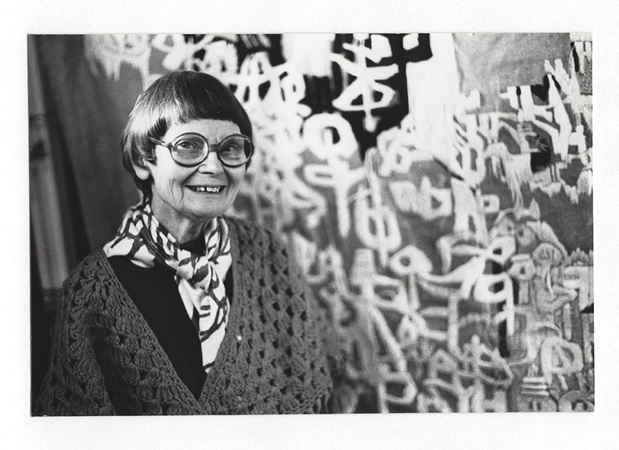Lissy Funk “The Secret Fish (Der geheime Fisch), 1964”
JTT

This event has ended.
JTT presents a single tapestry by Lissy Funk, titled The Secret Fish (Der geheime Fisch) and completed in 1964.
Artist’s chronology:
1909:
Lissy Duessel is born in Berlin and moves with her family to Cologne
1909-14:
Spends her summers in St. Eppan, in the South Tyrol where her color sensibility is formed in part by her experiences there
1914:
Moves with her family to Munich
1921:
Begins to study dance with Mary Wigman in Dresden
1923:
Family moves to Mendriosotto, canton of the Ticino
1925:
Lissy no longer dances, and later states, “As captivating as dance was for me, I could not see my future in it. Drawing and painting were too fast for me - I needed something that would grow from within, that I could create slowly, at my own pace.”
1927:
Begins to embroider
1929-30:
Studies weaving in St. Gallen with Martha Goggenbühk
1933:
Moves to Zurich
1935:
Lissy Duessel marries painter Adolf Funk. “He painted and I embroidered; each of us did our own work separately, and yet we were together.”
1935-37:
Teaches needlework at the Frauenarbeitsschule (School for Working Women) in Basel
1937:
Establishes a studio on Seefeldstrasse in Zurich and sees for the first time, large, late medieval French tapestries at the World’s Fair in Paris. “I was overwhelmed by the ‘Lady with the Unicorn’, and a series of tapestries from Beaune with birds and the words ‘Seule’ (signifying seule étoile, or ‘only star’) woven into them over and over. This was the device that the donors, Nicolas Rolin and his wife Guingonde de Salins, used to espress their love for one another. At the same time, I saw Flemish and English tapestries dating from the fifteenth and sixteenth centuries. My enthusiasm for them was boundless. These works became my teachers. Their compositions have a quiet, powerful rhythm. Their very beauty is emotionally expressive. The exquisite colors and accomplished handiwork — all these elements create such a full image. ‘The whole world is expressed in them,’ I told myself. ‘This is how it must be.’ ”
1938:
Wins a competition for wall hanging for the council chamber (Kantonsratsaal) of the city hall (Rathaus) of Zurich
1939-45:
Works on large wall hanging for the city hall of Zurich
1940:
Lissy and Adolf have a daughter Rosina
1942:
and a son Christian
1948:
Moves a studio to Kalchbühlstrasse in Zurich
1948-76:
Teaches needlework at the Hauswirtschaftliche Fortbildungsschule in Zurich
1948:
Ten tapestries by Jean Lurçat were installed in the Great Hall of the Kunsthaus in Zurich; in each the artist had placed striking colors against a black background. Lissy is inspired by the work greatly.
1961:
Won gold medal at international exhibition of liturgical art at Trieste, Italy
1972:
Adolf Funk publishes paintings of fish in a catalog titled “Unsere Fische” with text by his brother Fritz Funk. Adolf is an avid fisherman and each of the paintings detail a specific fish he has observed from life.
1976:
Honored by the canton of Zurich
1977:
Won prize at international textile exhibition at Vevey
2005:
Dies in Zurich
The above chronology was taken from the catalog that accompanied the exhibition “Lissy Funk — A Retrospective,” held at The Art Institute of Chicago in 1988 and organized by Christa C. Mayer Thurman.
Media
Schedule
from May 24, 2015 to June 21, 2015
Opening Reception on 2015-05-24 from 18:00 to 20:00